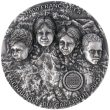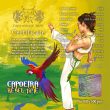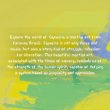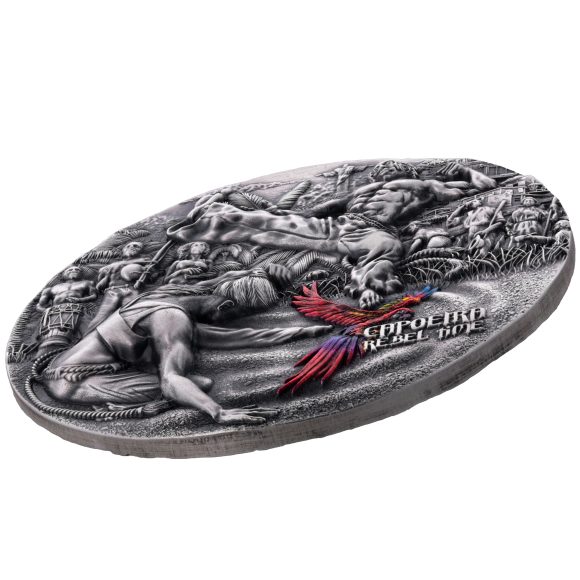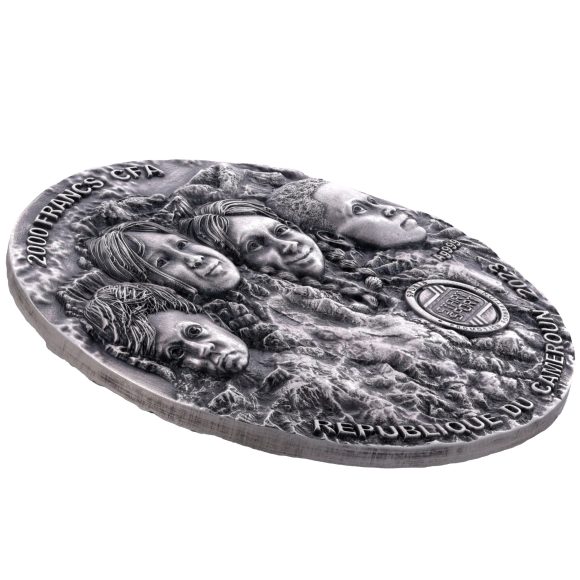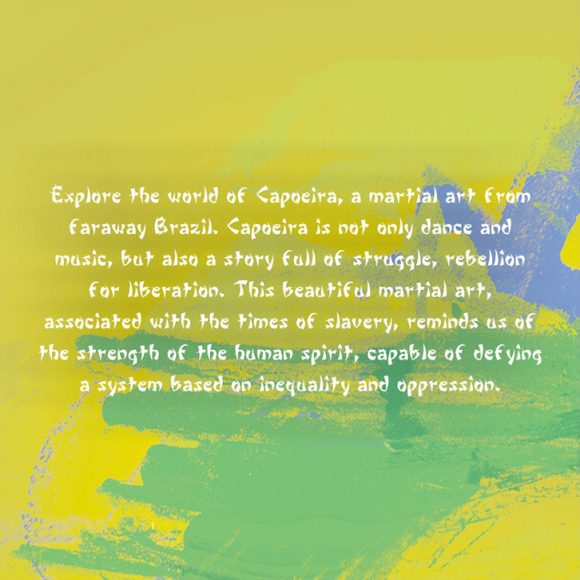Regarding the future of the REBEL TIME series, the authors of the series want to present various historical rebellions in subsequent editions, as many of them have happened in history……
Capoeira
| Rebel Time | |
| Year of issue: | 2023 |
| Issuer country: | Cameroon |
| Face Value: | 2000 CFA |
| Metal: | Silver |
| Purity: | AG.999 |
| Weight: | 2 oz |
| Dimensions: | 50 mm |
| Relief: | Ultra-high relief |
| Finish: | Antiqued |
| Additional: | UV print |
| Mintage: | 500 pieces |
Description
A reverse to the cunning martial art of Capoeira as a symbol of the fight against a system based on enslavement and oppression. On the left side of the coin, among the Amazon jungle – a symbol of harmony and the power of nature, we see three Capoeiras playing instruments – the first man from the left plays the Atabaque, the second the Berimbau („sacred bow”) and the woman the Pandeiro. The battery („Orchestra”) sets the rhythm for the competition between two Capoeiras – a woman and a man.
The man performs a high spinning Martelo kick, and the woman gracefully avoids his attack using the Negativa technique. This competition is a metaphor for the struggle between the two elements of water and fire, which wanted to determine who is stronger. The fire tried to burn the water, and the water tried to extinguish the fire. However, both elements were equally strong and could not defeat each other. Eventually, it was concluded that water and fire were equally important and that both were necessary for life to exist. This metaphor emphasizes that competition does not always have to result in defeating the other side, but can lead to understanding and respect for differences between people, cultures or ideas. Capoeiras competition takes place in a circle called Roda („Wheel of Life – which represents the cycle of life, death and rebirth).
At the top in the center of the coin, above all the episodes, is the backwards statue of Jesus Christ of Rio de Janeiro, also known as Christ the Redeemer. Symbolically, the statue of Jesus with its back turned reflects the demoralization of life, reminding us of the need for internal transformation and striving for moral values such as love, respect, kindness and care for others. It is also a hope for redemption and reconciliation in society, even in situations where it seems impossible.
On the right, against the background of today’s habitats of poverty and crime, the Favelas are a symbol of social inequality, poverty and lack of equal opportunities in access to education, work and housing. Favelas also symbolize the lack of control and limited powers of the state, which is often unable or unwilling to provide residents with basic services and security. On the other hand, favelas also have their own unique lifestyle and culture, which can be seen as a symbol of social strength and resilience, despite difficult living conditions.
Below the Favela we see slave-working women and men from colonial times. This episode reminds us of the dark side of history that has lasted for many hundreds of years and still continues, but in a different dimension. We refer the symbol of slavery in Brazil to the general context of the fight for freedom, equality and justice around the world. Slavery was a violation of basic human rights and a manifestation of the absolute power of some people over others. This struggle was and still is, and slavery was one of its many historical stages.
Slavery was also part of a broader problem of failure to respect human dignity and human rights by authorities and governments. Not only in Brazil, but around the world, governments and authorities often abuse their power to limit freedom and subjugate people. Slavery was just one of the many ways this manifested itself.
Overall, the slave symbol on the Rebel Time series coin is intended to remind us of the need to fight for freedom, equality and justice for all people. It also reminds us that as a society we must work to protect human rights and avoid abuses of power.
At the bottom right of the coin there is a macaw parrot, this intelligent, independent and brave bird, with strong and durable features, we interpret the entire message based on the geographical part of South America as a symbol of tenacity and determination in the fight for freedom, hope and emancipation.
The inscription CAPOEIRA with the name of the REBEL TIME series is placed under the parrot.
At the bottom there is a parrot in flight, which is a symbol of the wild nature of the Amazon, but we also identify it as freedom, hope and liberated.
Under the bird there is the inscription CAPOEIRA with the name of the REBEL TIME series.
The obverse of the coin shows analogies to Mount Rushmore with the heads of American presidents, which is located in the Black Hills area, considered a sacred place for the indigenous people of North America, especially the Lakota Sioux. In our interpretation, on the fictional peak of Mount Hope, there are huge heads of children of four nationalities: Slavic, Asian, Indian Native American – Indian and African. The head of a Slavic child represents the strength and determination of the Slavs, who have survived many difficult times and are still an important element of world culture and history. The head of an Asian child represents the wisdom and harmony that Asians bring to the world. The head of an Native American child symbolizes the beauty and spirituality of the indigenous people of North America, and the head of an African child – the perseverance and strength of character of African Americans who have gone through many difficult times and yet remain steadfast and proud of their heritage.
Regarding the future of the REBEL TIME series, the authors of the series want to present various historical rebellions in subsequent editions, as many of them have happened in history. We are currently working on portraying the Samurai Rebellion, also known as the Satsuma Uprising or the Samurai Rise. This armed uprising took place in Japan in 1877. Warriors of samurai origins resisted the new government and its army, which sought to limit their political influence and change the traditional feudal system to modern, centralized rule. The Samurai Rebellion arose from changes taking place in Japan in which traditional values and culture clashed with Western influences such as modern technology, industry, and political ideologies. Even though the rebellion was suppressed, it became a symbol of resistance and the fight for traditional Japanese values in the face of a changing reality.
Work is also underway to present the Gladiator Rebellion.
A gladiator rebellion took place in ancient Rome in 73-71 BC. It was a rebellion organized by slaves (mainly gladiators) against the Roman authorities and the institutions of slavery. During the rebellion, the slaves won several victories over the Roman armies, the leaders being Spartacus (the most famous), as well as two Gauls, Crixus and Oenomaus. Nevertheless, after three years of fighting, the rebels were defeated by the Roman general Marcus Licinius Crassus, and hundreds of them were publicly executed by crucifixion. Despite this, the gladiator rebellion became a symbol of the fight against oppression and exploitation, and the figure of Spartacus gained fame as a hero of the fight for freedom.
Download materials here.






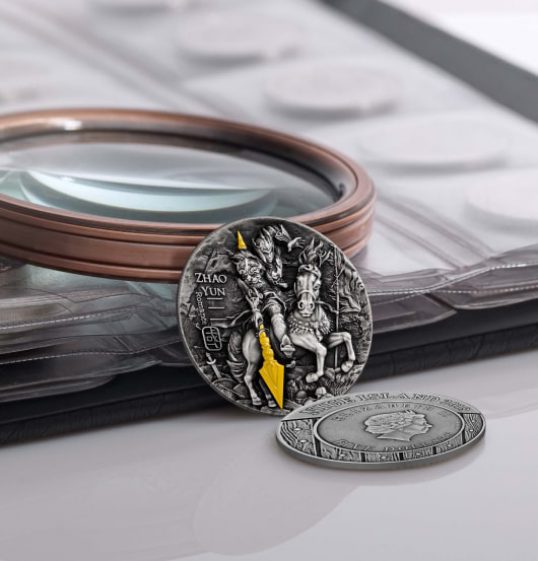
Twoje pytanie zostało pomyślnie wysłane. W niedalekiej przyszłości otrzymasz odpowiedź.

Sprawdź swój e-mail, aby otrzymać wiadomość potwierdzającą.





